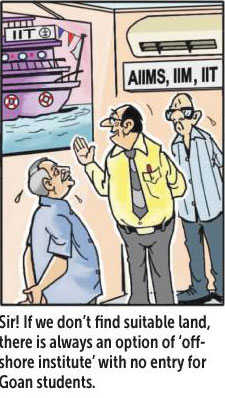21 Feb 2018 | 06:28am IST
Drinking water crisis worldwide, is Goa prepared to handle it?
Drinking or portable water is the most precious resource that humans use since time immemorial. Many civilisations were born and lost on account of water. Water shortage affects every continent and more than 1.2 billion population lack access to clean drinking water. According to Water Aid report (2016), nearly 76 million people in India do not have access to safe drinking water. Rampant pollution and dumping of sewage in reservoirs, and soaring population have pushed India towards an enormous water deficit. Though India is blessed with many rivers, poor storage infrastructure over the years has created a water crisis. However, more than 54% of the ground water in the Indo-Gangetic Plain and other states is undrinkable and unusable for irrigation due to elevated salt, mercury and arsenic levels.
The water scarcity scenario worldwide is also grim. Confronted by the worst drought 4 million residents in South African city of Cape Town is heading for dry taps from mid-April this year. Australian major cities are also heading for ‘day zero’ water catastrophe and their only lifeline is desalination plants with rationing on anvil. Brazilian capital São Paulo is at the height of the crisis, with over 21.7 million inhabitants likely to go dry this year. 40% of the surface water in Danjiangkou reservoir which supplies water to 20 million inhabitants of Beijing is polluted with heavy metals to the point of not being useful even for agriculture or industrial use. Contamination of reservoirs with untreated waste is affecting the Nile in Egypt, Moscow is becoming contaminated with untreated agricultural and residential, which will eventually lead to critical water shortages in the country
What’s causing the water scarcity? It is being driven by growing freshwater demand with limited natural resources and depletion of usable freshwater resources largely due to over harvesting (mismanagement) and draught. According to a research paper published in the journal Nature Geoscience, changing rainfall pattern is the key factor driving changes in groundwater storage in India. Underground aquifers are charged from surface water bodies and rain, and discharged as people pump out water at an unsustainable rate for drinking, industry, and agriculture. The rainfall has been deficit by -12% in 2004, -21% in 2009, -8% in 2012, -12% in 2014, -14% in 2015, -3% in 2016, -5% in 2017, for the entire country.
According to UN, the global use of freshwater doubled between 1964 and 2014 because of population growth, urbanisation, industrialisation and increased production and consumption. The demand for water in cities is expected to grow by 50% by 2030. The Union Ministry of Water Resources has estimated the country’s current water requirements to be around 1100 billion cubic meters per year, which is projected to be around 1200 billion cubic meters for 2025.
What’s role of climate change on water scarcity? According to the International Panel on Climate Change (IPCC) 2014 report for every degree Celsius of global warming, about 7% of the world’s population will face 20% drop in water requirement. Climate change through global warming is making the world hottest regions more scorching, moving the clouds away from equator toward poles, depriving / scanty rain in the tropical countries. Climate change is also brings heavy rains on other areas making them vulnerable to floods and natural disasters. Retreating glaciers have reduced fresh water supply to Indo-Gangetic Plain.
Goa receives bounty rainfall of 3,227 mm, most of which flows into the sea due to highly undulating topography and underlying hard rocks. 11 perennial rivers that originate in the Western Ghat form the lifeline of freshwater water in Goa. Mountainous terrain, mining, river diversion, and overharvesting of groundwater are some problems that contribute to water shortage in Goa. Villages in Sanguem, Canacona, Pernem and Sattari in Quepem Taluka are worst hit during March to mid-June as they are situated on hills, so the pressure in not sufficient to pump the water. The water carrying capacity of all the rivers in Goa is rapidly going down due to growing silt accumulation mainly from the mining rejects. Deforestation along the hill slopes due to mining activity has destroyed natural mechanism of aquifer and the ecological destruction has also affected the rainfall pattern of the area. Builders are on rampant construction spree leaving not much open space for water to percolate in the ground. And above all, the 15 lakh plus population in Goa and twice that number of tourists who use 2-3 times the water Goan people use, is yet another reason for stress on this portable resource.
Every year, parts of Mormugao, Sanvordem, Sanguem, Quepem, Salcette and Bicholim reel under acute water shortage, forcing people to depend on tankers for supply. Tanker companies have been exploiting ground water in some areas for commercial gains like supplying to hotels for swimming pools and garden & lawns, and other establishments, thereby lowering the ground water table year by year. According to the 2013 report of Central Ground Water Board report, there are 3359 wells, 14 shallow tube wells and 57 deep tube wells. About 30-40% of these are either polluted or abandoned due to high levels of faecal coliform bacteria. The report indicated that 49% of stations analysed showed a fall in the decadal change in water level in the North Goa district for the period November 2001 to November 2010 when compared with the groundwater level in November 2011. This calls for judicious ways of utilization of water by stake holders.
(The author is Scientist & Head, Polar Remote Sensing Section, National Centre for Antarctic and Ocean
Research, Headland Sada, Goa).
